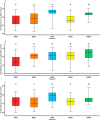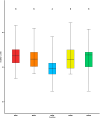Genotype-dependent response to water deficit: increases in maize cell wall digestibility occurs through reducing both p-coumaric acid and lignification of the rind
- PMID: 40416088
- PMCID: PMC12098441
- DOI: 10.3389/fpls.2025.1571407
Genotype-dependent response to water deficit: increases in maize cell wall digestibility occurs through reducing both p-coumaric acid and lignification of the rind
Abstract
Introduction: The compositional dynamics of the cell wall are influenced by drought, and it has been demonstrated that water deficit induces significant changes in its main components. Moreover, changes in cell wall concentration and distribution in response to water deficit affect maize degradability.
Material and methods: This study presents a histological and biochemical analysis of thirteen maize inbred lines, evaluated over two years in Pobra de Brollón (Spain) and Mauguio (France) under contrasting water availability conditions. Our aim was to investigate the environmental and genotypic impacts on histological and biochemical profiles, to assess in vitro cell wall digestibility under water deficit, and to explore how these responses relate to changes in cell wall composition and structure.
Results and discussion: Overall, we observed greater concentrations of p-coumaric acid under control conditions, with significant decreases in stressed conditions at each location. Histologically, we found an increase in non-lignified tissues under water deficit conditions across all tissues at each location as well. In terms of in vitro cell wall digestibility (IVCWRD), significant increases were detected in response to water deficit. Additionally, genotype-dependent response patterns were evident, revealing two distinct behavioural groups. Notably, in plastic genotypes, increases in IVCWRD in response to water deficit were concomitant to reductions in p-coumaric acid content and a decrease in red-stained lignified tissues in the rind. This study emphasizes the complex, genotype-dependent responses to water deficit, underscoring the important roles of plasticity and stability in shaping the impact on maize cell wall digestibility; paving the way to breed for adapted genotypes to face climate changes.
Keywords: cell wall digestibility; drought, maize; histology; lignification; p-coumaric acid.
Copyright © 2025 López-Malvar, Main, Guillaume, Jacquemot, Meunier, Revilla, Santiago, Mechin and Reymond.
Conflict of interest statement
The authors declare that the research was conducted in the absence of any commercial or financial relationships that could be construed as a potential conflict of interest.
Figures









References
-
- Amin B. A. Z., Chabbert B., Moorhead D., Bertrand I. (2014). Impact of fine litter chemistry on lignocellulolytic enzyme efficiency during decomposition of maize leaf and root in soil. Biogeochemistry 117, 169–183. doi: 10.1007/s10533-013-9856-y - DOI
-
- Barrière Y., Guillaumie S., Denoue D., Pichon M., Goffner D., Martinant J. P. (2017). Investigating the unusually high cell wall digestibility of the old inra early flint f4 maize inbred line. Maydica 62, 21–41.
LinkOut - more resources
Full Text Sources

